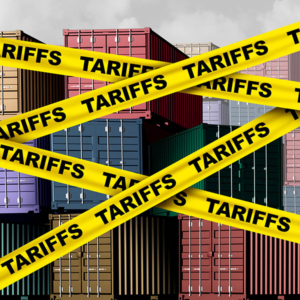
On April 2, President Trump signed an executive order imposing a 10% tariff on imports from around 60 countries as well as a 26% “reciprocal tariff” on India, a major jewelry manufacturer. The order also hikes China’s levy to 54%.
According to the executive order, beginning 12:01 a.m. on Saturday, April 5, the U.S. will collect a minimum 10% tariff on imports from all trading partners, except for goods deemed compliant with the United States-Mexico-Canada Agreement (USMCA). Imports deemed noncompliant will continue to be charged at the 25% rate implemented last month.
On Wednesday, April 9, countries that have high trade deficits with the United States will face what the White House calls “reciprocal tariffs.” While most countries don’t have duties as high as the new American ones—these tariffs give the U.S. the highest rate of any industrialized nation—Trump said he was responding to “nonmonetary barriers and other forms of cheating,” such as value-added taxes and supposed currency manipulation.
The list of affected countries includes China—which was hit with a new 34% tariff, in addition to the 20% already in effect—as well as such diamond, jewelry, and watch manufacturing countries as Vietnam (a 46% levy), Botswana (37%), Thailand (36%), Switzerland (31%), and Israel (17%). The tariff for European Union (EU) countries will be 20%.
(Among the goods that won’t be subject to the tariffs: gold and silver bullion and raw platinum.)
The CEO of major jewelry manufacturer, who didn’t want to be identified since the issue is politically fraught, tells JCK: “I’ve been on the phone with manufacturers for the last 24 hours. I don’t think the 26% tariff on India will ever go away completely. Once governments get ahold of money, they never give it up. President Trump is not going to give up all that income and make himself look foolish.
“Memo will be dead. Who’s going to memo stuff when they have to pay 26% up front? I believe that all of this, on top of the high gold price, will likely be a very bad thing for the industry and consumers…. We’ll have to deal with it.”
Jewelers of America president and CEO David Bonaparte tells JCK via email: “Tariffs have and will impact the jewelry industry. Jewelers of America has heard from members who got hit by jewelry packaging tariffs during the first Trump administration and the toll those took on their businesses and customers. The possibility of broader and sweeping tariffs is a real concern.
“Because tariffs are paid by the U.S. importer, they ultimately get passed on to consumers through higher prices,” he added. “If American consumers are facing increased costs—on top of existing inflation—they are more likely to cut back on discretionary spending such as jewelry.”
An article posted last month by India’s Gem & Jewellery Export Promotion Council (GJEPC) urged an end to any trade hostilities—though it dramatically underestimated the size of the eventual tariffs.
“If a 5%-6% tariff hits loose diamonds, it’ll drastically raise jewelry costs—a $10,000 stone jumps by $500-$600,” said Ajesh Mehta, convener of the diamond panel for GJEPC. “This isn’t a win for the U.S.—it kills their jewelers’ labor advantage. Margins for Indian diamond manufacturers will vanish, sales will plummet, and rough diamond prices must drop 6% to compensate.”
Analyst Paul Zimnisky tells JCK: “On a micro level, this will certainly complicate the trade’s supply chain, especially in the short term—there are a lot of moving parts. On a more macro level, this will likely be inflationary, which will impact overall consumer sentiment and spending ability….
“Overall, I would speculate that a lot of countries will cut or reduce their levies on the U.S. in the coming days and some of this will deescalate. I would expect continuous news flow in the coming days and weeks.”
Speaking to Bloomberg Television, Treasury Secretary Scott Bessent didn’t appear ready to assuage nervous businesspeople and trading partners.
“We’re just going to have to wait and see…. It’s going to be up to President Trump to see what he wants to do,” Bessent said. “I am sure that there’s going to be a lot of calls. I just don’t know if there’s going to be negotiations.”
Most countries have threatened to retaliate with high levies on imports from the United States. In response to prior tariffs, Canada instituted new fees on U.S.-made jewelry imports, and the EU has threatened to place tariffs on diamonds and gemstones exported from the U.S.
Skeptics called Trump’s actions too disruptive, especially for the current interconnected world. According to Apollo Global Management, 41% of revenue for companies on the S&P 500 comes from overseas.
“These policies, if sustained, would likely push the U.S. and global economy into recession this year,” JPMorgan analysts wrote in a note quoted by Axios.
The National Retail Federation (NRF), which has been a consistent foe of tariffs, said in a statement that the new duties will be “particularly harmful” to smaller retailers.
“More tariffs equal more anxiety and uncertainty for American businesses and consumers,” said David French, NRF’s executive vice president of government relations. “The immediate implementation of these tariffs is a massive undertaking and requires both advance notice and substantial preparation by the millions of U.S. businesses that will be directly impacted.”
Announcing the tariffs in the Rose Garden, Trump predicted that April 2, which he dubbed Liberation Day, will be “one of the most important days…in American history….
“For decades, our country has been looted, pillaged, and plundered by nations near and far, both friend and foe alike,” he said. “Foreign cheaters have ransacked our factories, and foreign scavengers have torn apart our once beautiful American dream.”
(Photo: Getty Images)
- Subscribe to the JCK News Daily
- Subscribe to the JCK Special Report
- Follow JCK on Instagram: @jckmagazine
- Follow JCK on X: @jckmagazine
- Follow JCK on Facebook: @jckmagazine





